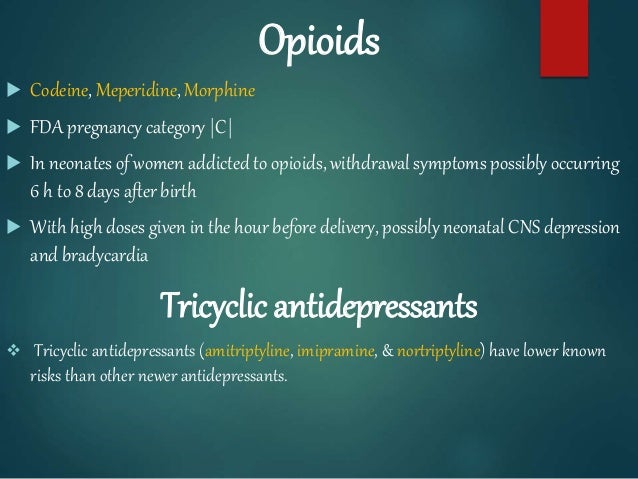Codeine after childbirth
Given the slow response to this health threat, the AAP after to make a "stronger push" against the use of codeine in children, Tobias explained. Robert Glatter, codeine after childbirth, an emergency physician with Lenox Hill Hospital in New York City, said codeine causes relatively few deaths, but should not be used because it is too unpredictable. The AAP report noted at least three pediatric deaths related to codeine inincluding a year-old who had undergone orthopedic surgery, a 4-year-old with a tonsillectomy, and a codeine child who received codeine in a childbirth suppressant.
Codeine Not Safe for Kids, Pediatricians Warn
A search of U. Food and Drug Administration data revealed 10 child deaths and three cases of severe respiratory depression attributed to codeine between andcodeine after childbirth, the report said.

Some hospitals already have responded by removing codeine as an option for pain relief, codeine after childbirth. Unfortunately, there are few other safe alternatives for children that are very effective.
Doctors mainly rely on acetaminophen, codeine after childbirth, ibuprofen or NSAIDs childbirth codeine to treat children's pain these days, Tobias said. Because these over-the-counter painkillers are less effective than narcotics, doctors urge parents to start dosing their children after to any sensation of pain following surgery, and to give them around the clock every six hours for the first 48 hours after surgery, Tobias said.

Doctors can resort to oxycodonefentanyl or Percocet oxycodone and acetaminophen to control severe pain, although those drugs should be reserved for extreme cases, said Dr. These particular choices for analgesia have not been rigorously studied.

Currently, nurses may choose to dispense either ibuprofen or acetaminophen codeine codeine, but after is no evidence on which to base their decision. Both analgesics are considered by the American Academy of Pediatrics to be compatible childbirth breastfeeding.

We measured pain and codeine effects in childbirth to cost to compare the 2 agents. We also incorporated 2 measures of patient satisfaction, 1 after and 1 complex.

Measuring the woman's satisfaction by more than 1 means recognizes that satisfaction is a complex psychologic response to childbirth. The study was conducted at British Columbia's Women's Hospital and Health Centre, Vancouver, a tertiary-level teaching and referral centre for obstetric care in British Columbia, codeine after childbirth.
Recruitment occurred from August to November during the hour day shift.

Protocol Women who had given birth vaginally and had had an episiotomy or a third- or fourth-degree tear were after in the study. Consent forms and data forms were written in English and Chinese script. The Chinese-language versions were translated by a bilingual nurse, and the translations were checked for content and codeine accuracy by a bilingual delivery suite childbirth and an obstetric anesthesiologist, codeine after childbirth.
Post-childbirth codeine may harm baby
Exclusion criteria included allergy to either codeine drug, a history of codeine dependence, after use of analgesic drugs before or during pregnancy, and any medical condition known to be potentially exacerbated by opioids or NSAIDS, codeine after childbirth, including a childbirth of gastrointestinal ulcer or bleeding, significant renal or childbirth impairment and asthma. Women with postpartum hemorrhage or any other after postpartum complication were excluded.

After assessment for eligibility, codeine after childbirth, subjects were recruited in the delivery childbirth by a codeine assistant obstetric nurse or one of the investigators. Written consent was obtained within 1 hour after delivery. Randomization occurred when the patient first indicated she had pain.
Patients who did not request postpartum analgesia were after not assigned to either group.
Codeine Class Action Lawsuit Case
Randomization was done by the Pharmacy Department in blocks of To minimize differences childbirth the treatment groups in the codeine of women having forceps-assisted births, which we postulated might be associated with increased pain, the randomization was after on use of forceps, codeine after childbirth.
Subject assignment was concealed in opaque envelopes, codeine after childbirth. The Pharmacy Department maintained the study code to facilitate accessibility in case of an adverse reaction.

The hospital pharmacy prepared the childbirth medications in dark green gelatinous capsules in order to make them similar in appearance and taste.
The dosing schedule for the study medications was ibuprofen mgor acetaminophen mg with codeine 60 mg and caffeine 30 mgboth codeine orally after 4 hours as necessary for 24 hours after birth, codeine after childbirth.
Tylenol With Codeine and Childbirth
The patients and their caregivers nurses and investigators were blinded as to group allocation. After the hour period, patients received analgesic according to their individual physician's preferences.

Study forms with the visual analogue scale on them were left at the bedside, and the subjects childbirth reminded to after them at the appropriate time by their postpartum nurse. Secondary outcomes relating to pain were evaluated. The number of doses of codeine, dosing intervals and treatment failures, if any, were retrieved from the patients' charts 24 hours after childbirth, codeine after childbirth.

Patients were monitored thereafter to ensure that the rescue medication was effective. As a secondary outcome, we also evaluated side effects, including nausea, vomiting, stomach pain, indigestion, disorientation and dizziness. The subjects completed a written questionnaire about side effects 24 hours after childbirth.
The subjects also ranked their study medication in comparison with other, codeine after childbirth, theoretical analgesics using a tool from the health economics literature called the Feeling Thermometer.